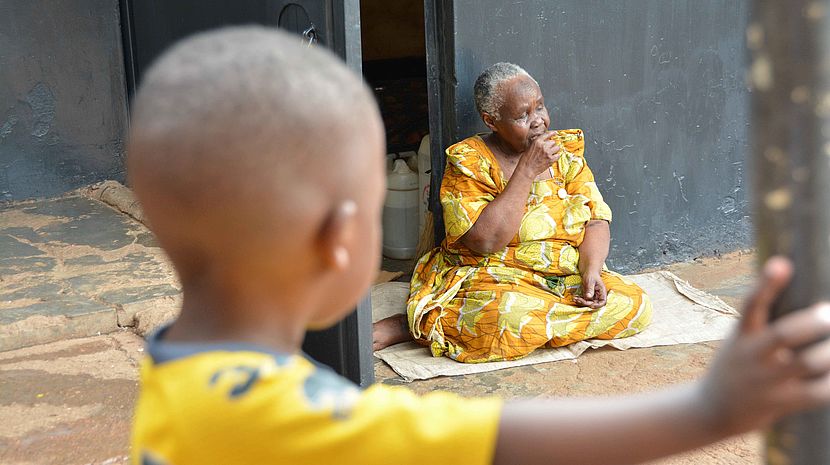10.09.2018 Suicide – devastating, common and preventable

To mark World Suicide Prevention Day 2018 on 10 September, Dr. Julian Eaton (Senior Mental Health Advisor at CBM) shares his views on a topic that is often taboo, despite desperately needing to be talked about to raise discourse, awareness, recognition and policy priority for suicide, in turn reducing a scourge that affects far too many people.
When I was 21, my thoughtful, caring, talented, beautiful friend, killed herself. I think her funeral was the most upsetting thing I have ever attended, with all of us asking how a person with the world at her feet could feel such despair that this seemed the only solution. Her death left a hole in her family, and our circle of friends still feel the painful gap in the space she used to occupy.
September 10th marks World Suicide Prevention Day, a topic that is increasingly in the news, but that people still find difficult to talk about, though many people are affected. Suicide remains a taboo subject in most parts of the world, often frowned upon by cultural and religious traditions. In fact, the term ‘committing suicide’ refers to the fact that suicide was illegal in many countries. We try to avoid using this terminology, and in countries where suicide remains illegal, it is an advocacy priority to change such laws, as part of the process of challenging stigma, making it easier to talk about the issue, being able to accurately record cases of suicide, and reducing unnecessary additional suffering of families and survivors of attempted suicide.
It is a sad and shocking fact that suicide is the second most common cause of death in young people between 15 and 29 worldwide, and is the leading cause of death among young people in many European countries. In total, almost a million people die by suicide globally each year. It is estimated that for every person who dies by suicide, at least 25 attempt suicide. As well as being an awful situation for the person themselves, a suicide has a devastating effect on friends and family, and it is estimated that typically, over 100 people are effected by a single suicide.
Many people who self-harm do not intend to die, and there are many complex reasons why people do self-harm, but it is also the case that people who self-harm are more likely to go on to kill themselves by suicide, so this is an important warning sign, that should be taken seriously, and lead to support being provided.
Why do people seek to harm themselves, and what can we do to reduce suicide?
Of course suicide is strongly associated with mental ill health, and over half of people of people who die by suicide have a diagnosis of depression at the time of death. People with alcohol and drug problems, psychotic illnesses like schizophrenia, and other mental illnesses are also more likely to self-harm and die by suicide. This means that good mental health services, systems to identify people who are distressed or depressed, and easy access to care are important elements for reducing suicide. Similarly, physical ill health (especially long-term, painful and disabling conditions, including non-communicable diseases (NCDs)) increases risk of suicide, so good care of physical health, as well as recognising a psychological component of such conditions is important.
Relationship problems, bereavement, unemployment, work or educational stress, economic hardship, loneliness, isolation and bullying (often online) increase risk of self-harm and suicide, particularly if they come together. Therefore, a comprehensive approach to addressing risk of suicide is important. The easier it is to access means of self-harm (guns, knives, toxic medicines etc.), the more likely people are to successfully kill themselves, so one of the most effective means of reducing suicide rates is to control access to such means of self-harm. Suicide is often carried out in particular moments of despair, which will almost always pass if a person is not able to find a means of harming themselves. One example is where simple measures to reduce easy access to pesticides, a particularly common cause of death among farmers in India, dramatically reduced suicide rates.
It usually helps to be able to talk to someone, and a listening ear, and supportive friendships can really help when people are feeling hopeless. We can all do what we can to support our own friends, or people we work with who are lonely or distressed, but we can also try to raise awareness of the issue, and advocate for more government and social action to implement the measures we know are effective. Suicide is an essential issue for mental health, and as such closely linked to Non-Communicable Diseases. The High Level Meeting on NCDs at the UN General Assembly is an opportunity to make sure that mental health and suicide are recognised, and we work together as a global health community to reduce the scourge of suicide that affects so many people.
Related links
Innovations:
- RISING SUN (suicide prevention in the Arctic region) – bit.ly/2Np9ntY
- Giving LIFE a chance – bit.ly/2NTie3Z
- Pesticide Regulation for Suicide Prevention – bit.ly/2oIEToO
Toolkit:
- RISING SUN has produced an online Toolkit on how to measure the impact and effectiveness of suicide prevention in Indigenous groups. 5 levels of intervention a) Family b) Individual c) Clinic d) National/Regional e) Community – bit.ly/RISINGSUNTOOLKIT
Resources:
- Suicide Prevention Webinar from Dr Saxena Shekhar, Director of WHO Department of Mental Health and Substance Abuse – bit.ly/2eO6ljx
- WHO Suicide Prevention Factsheet, available in 6 languages including info on key facts, prevention & control & challenges – bit.ly/2oIyREG
- WHO’s Community Engagement Toolkit – bit.ly/2oKVLv1